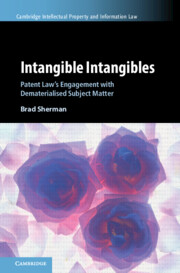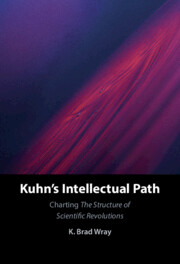68 results

Intangible Intangibles
- Patent Law's Engagement with Dematerialised Subject Matter
-
- Published online:
- 25 April 2024
- Print publication:
- 09 May 2024
-
- Book
-
- You have access
- Open access
- Export citation
Simultaneous Mineralogical Quantification and Chemical Characterization of Soil Clays
-
- Journal:
- Clays and Clay Minerals / Volume 42 / Issue 6 / December 1994
- Published online by Cambridge University Press:
- 28 February 2024, pp. 747-754
-
- Article
- Export citation
Eocene and Oligocene Otay-Type Waxy Bentonites of San Diego County and Baja California: Chemistry, Mineralogy, Petrology and Plate Tectonic Implications
-
- Journal:
- Clays and Clay Minerals / Volume 47 / Issue 1 / February 1999
- Published online by Cambridge University Press:
- 28 February 2024, pp. 70-83
-
- Article
- Export citation
Supergene Origin of the Lastarria Kaolin Deposit, South-Central Chile, and Paleoclimatic Implications
-
- Journal:
- Clays and Clay Minerals / Volume 47 / Issue 2 / April 1999
- Published online by Cambridge University Press:
- 28 February 2024, pp. 201-211
-
- Article
- Export citation
10 - Science and the Sublime
- from Part II - Romantic Sublimes
-
-
- Book:
- The Cambridge Companion to the Romantic Sublime
- Published online:
- 06 July 2023
- Print publication:
- 20 July 2023, pp 129-140
-
- Chapter
- Export citation
A new species and new combination of Lecanora s. str. (Lecanoraceae) from China
-
- Journal:
- The Lichenologist / Volume 55 / Issue 3-4 / July 2023
- Published online by Cambridge University Press:
- 13 June 2023, pp. 115-124
- Print publication:
- July 2023
-
- Article
- Export citation
5 - Chemistry: Exploring Pluriliteracies through a Deeper Learning Episode on Redox Reactions
- from Part II - Deeper Learning Episodes: First Steps towards Transforming Classrooms
-
-
- Book:
- A Deeper Learning Companion for CLIL
- Published online:
- 04 February 2023
- Print publication:
- 23 February 2023, pp 21-48
-
- Chapter
- Export citation
11 - Coleridge and Science
-
-
- Book:
- The New Cambridge Companion to Coleridge
- Published online:
- 13 November 2022
- Print publication:
- 24 November 2022, pp 161-177
-
- Chapter
- Export citation
Chapter 8 - Systems and Centos
-
-
- Book:
- Genre in English Medical Writing, 1500–1820
- Published online:
- 13 October 2022
- Print publication:
- 13 October 2022, pp 108-127
-
- Chapter
- Export citation
7 - Coexisting Cryptic Species as a Model System in Integrative Taxonomy
-
-
- Book:
- Cryptic Species
- Published online:
- 01 September 2022
- Print publication:
- 08 September 2022, pp 169-196
-
- Chapter
- Export citation
Molecular, morphological and chemical variation of the Usnea pectinata aggregate from Tanzania, São Tomé and Príncipe
-
- Journal:
- The Lichenologist / Volume 54 / Issue 5 / September 2022
- Published online by Cambridge University Press:
- 29 November 2022, pp. 291-298
- Print publication:
- September 2022
-
- Article
- Export citation
Chapter 1 - Immunohistochemistry Fundamentals
-
-
- Book:
- Immunohistochemistry
- Published online:
- 16 June 2022
- Print publication:
- 07 July 2022, pp 1-23
-
- Chapter
- Export citation
65 - Undergraduate Research in France
- from Part IV.4 - Europe
-
-
- Book:
- The Cambridge Handbook of Undergraduate Research
- Published online:
- 11 August 2022
- Print publication:
- 07 July 2022, pp 591-598
-
- Chapter
- Export citation
Interdisciplinary analysis of drugs: Structural features and clinical data
-
- Journal:
- Journal of Clinical and Translational Science / Volume 6 / Issue 1 / 2022
- Published online by Cambridge University Press:
- 29 April 2022, e43
-
- Article
-
- You have access
- Open access
- HTML
- Export citation
6 - Patriotic Economics and the Making of a National Currency
-
- Book:
- Money in the Dutch Republic
- Published online:
- 03 March 2022
- Print publication:
- 10 March 2022, pp 175-206
-
- Chapter
- Export citation
4 - Metallurgy and the Making of Intrinsic Value
-
- Book:
- Money in the Dutch Republic
- Published online:
- 03 March 2022
- Print publication:
- 10 March 2022, pp 95-135
-
- Chapter
- Export citation
5 - Quantum Computing Applications
- from Part 01 - Quantum Technologies
-
- Book:
- Law and Policy for the Quantum Age
- Published online:
- 18 November 2021
- Print publication:
- 06 January 2022, pp 173-228
-
- Chapter
-
- You have access
- Open access
- Export citation
Chapter 15 - Science
- from Part III - Disciplinary Connections
-
-
- Book:
- The Cambridge Companion to British Romanticism and Religion
- Published online:
- 01 October 2021
- Print publication:
- 21 October 2021, pp 257-273
-
- Chapter
- Export citation

Kuhn's Intellectual Path
- Charting The Structure of Scientific Revolutions
-
- Published online:
- 02 February 2022
- Print publication:
- 30 September 2021
Chapter 3 - Kuhn and the History of Chemistry
- from Part I - The Groundwork for Structure: Harvard 1947 to 1955
-
- Book:
- Kuhn's Intellectual Path
- Published online:
- 02 February 2022
- Print publication:
- 30 September 2021, pp 50-64
-
- Chapter
- Export citation



